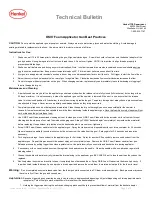
Technical Bulletin
Henkel TCS Department
26235 First Street
Westlake, OH 44145
1-800-624-7767
Technical Bulletin - OSI Foam Applicator Gun
– 20171003 Page
1
of
3
OSI® Foam Applicator Gun Best Practices
CAUTION:
Do not point the applicator gun at people or animals. Always wear eye protection, gloves and protective clothing. Avoid damage to
existing materials in replacement situations. Use a drop cloth to protect work area at all times.
Instructions for Use:
1.
Shake can well 15 to 20 times prior to attaching the gun. Align canister and gun. Screw black collar of canister onto the basket adapter of the
gun by hand until snug, being careful not to cross-thread the unit. Do not over tighten. NOTE: It is important to align threads properly to
prevent possible leakage
2.
Shake can well before use and during any work interruptions. Note: In colder temperatures we also recommend occasional shaking during
use to ensure consistent flow. Keep product temperature above 45° F for maximum performance and best flow rate.
3.
Aim gun into an appropriate receptacle such as a box or bag or on a disposable surface to test flow rate. Pull trigger to start the flow of foam.
4.
Adjust the control knob (release valve) on rear of gun to regulate flow. Clockwise decreases flow, counterclockwise increases the flow
5.
Do not store gun with empty canister on the gun. When changing canister, replace empty can immediately to avoid hardening or clogging of
foam in the applicator gun.
Maintenance and Cleaning:
1.
A partially used can may be left on the applicator gun between jobs when the release valve is fully closed (full clockwise), but no longer than
30
days’ maximum. It is not necessary to clean the applicator gun until the canister is removed. When not in use, ensure that the release
valve is in the closed position (full clockwise) to avoid foam curing up inside the gun. Temporary storage must always have a pressurized foam
can attached to the gun. Never remove a partially used/dispensed can as they are pressurized.
2.
Completely emptied cans must be replaced immediately. Clean the applicator gun thoroughly as soon as possible after the canister is
removed if no replacement can be available to avoid the foam hardening inside the applicator gun. Once the foam has cured, cleaners will not
work or dissolve the polyurethane foam.
3.
Use OSI® Foam Clean, pressurized cleaning solvent, to clean gun or use OSI® Foam Clean with button actuator on its valve stem for spot
cleaning and the clean up of uncured foam when changing cans. Always
CLEAN “basket adapter” completely of any residual foam material
before replacing. Use petroleum jelly lubricant on the basket adapter to prevent over- tightening
4.
Screw OSI® Foam Cleaner canister onto the applicator gun. Spray the cleaner onto a disposable surface or into a container for 3-5 seconds.
Open release valve partially (counterclockwise, but do not unscrew the value from the gun). Spray again for 3-5 seconds and repeat as
necessary.
5.
For Long term storage: Leave solvent in the applicator gun for 2 minutes. Spray for another 3-5 seconds to remove used solvent from the
applicator gun. Repeat this process until the solvent spray out is completely clean. Remove the OSI® Foam Cleaner canister from gun.
Release pressure by pulling trigger then close regulator valve. Use petroleum jelly on nozzle tip and basket before storing applicator.
6.
If necessary, with no can attached, unscrew the regulator knob and remove the needle. Clean the needle with a non-abrasive rag wet with
cleaning solvent.
7.
Grease the needle with petroleum jelly lubricant before replacing in the applicator gun. BE CAREFUL not to lose the parts as they cannot be
replaced.
8.
Routinely clean the screw-on brass tip to keep it completely free of hardened foam. Spray OSI® Foam Cleaner
into the brass tip’s cavity. If
foam has cured inside the brass tip, use a probe to break apart and remove the cured foam to maintain a clear path for the foam to travel.
Warning:
Do not completely unscrew release valve from the foam gun while connected to a PU foam or cleaner canister. Back pressure may cause
the valve to fly off from the gun and cause harm.
Helpful Hint:
Squeeze trigger when unscrewing an empty can, in order to depressurize dispensing unit (point dispensing unit into appropriate waste
receptacle). This will help to prevent backflow of material from the basket adapter
1. Holding the trigger open during the entire can changing process will help to prevent backflow of material from the basket adapter.





















